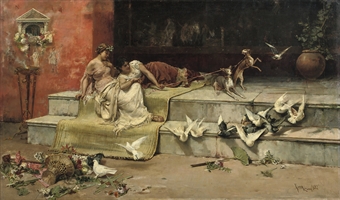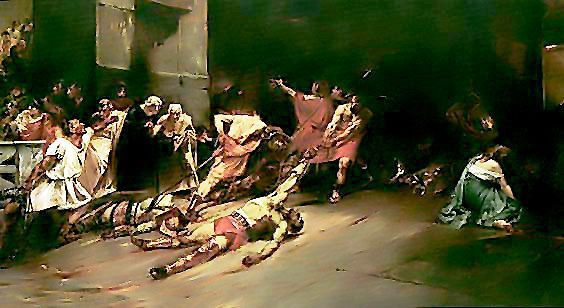Slow news day, so we'll mention this one from the Inquirer:
Christie's has an image of the Damas (larger version available at their site):

It seems odd that there are so few versions of Spoliarum available on the web (which is one of those huge, wall-sized works) ... here's the only one I could find:

As the source notes, it's 23 x 13 feet in size, and shows some dead gladiators being dragged away as a woman mourns in the corner. It is one of the treasures of the National Museum of the Philippines' collection and was considered to evoke the sacrifices and struggles of the Philippine people as they struggled to free themselves from the yoke of Spanish oppression.
A work by the Filipino master Juan Novicio Luna (1857-1899), believed to have been lost and missing for over a century, has surfaced and will be auctioned off by Christie’s during its Fall sale of Southeast Asian Modern & Contemporary Art on Nov. 30, in Hongkong, the auction house has announced.
“The recovery of an important and beautiful Luna will surely cause a stir on our art scene,” Ramon Orlina told the Inquirer. (Orlina’s sculptures are among those to be auctioned off.)
The found work is “Las Damas Romanas” (Roman Maidens), which will have a floor price of HK$8,000,000-10,000,000 or US$1,025,600-1,282,000).
Christie’s says the auction of the painting will surely be one of the highlights of the bidding.
“This extraordinary work was, until only recently, presumed lost as its whereabouts were unknown over a century since it was painted,” the auction house notes. “Its reappearance on the market now makes it one of only a small number of drawings, watercolors and oils by Luna that have surfaced in the past quarter of a century.”
Documentation on the work is scant. It was noted in the 1957 biography of Luna by Carlos E. Da Silva, and appeared as a faded black-and-white photograph from the file of the prewar art dealer and historian Alfonso T. Ongpin, which was reproduced by art historian and teacher Santiago Pilar in “Juan Luna: The Filipino as Painter,” published by the Eugenio Lopez Foundation in 1980.
The painting is an oil on canvas, 100 x 170 cm (around 39 x 67 inches). It is signed and dated “Luna Roman 1883” at the lower right.
Like “Spoliarium,” Luna’s most famous mural showing the corpse of a Roman gladiator being dragged in a chamber under the coliseum, “Damas” is also drawn from ancient Roman history but its elements are cheerful.
It shows two maidens on the steps of a building, one with her back reclining on a Roman pillar and the other, partly supine, holding on her leash, two frisky dogs trying to chase doves which are all around them, creating a merry scene of rest and languor. In the background is what appears to be a small shrine with incense smoke rising.
Allegory?
In his notes to the Christie’s catalogue, Ambeth Ocampo, Inquirer columnist and chair of the National Historical Institute, notes: “Should ‘Las Damas Romanas’ be seen at face value? Is it but a typical domestic scene in ancient Rome or does it have deeper, hidden meanings?”—much like “Spoliarium,” which Filipino propagandists and contemporaries of Luna in Madrid said was an allegory of the sufferings of
Filipinos under colonial Spain.
Ocampo takes particular note of the probable symbolic value of the doves, which he says, in ancient Rome, were given erotic connotations. “So, is this an allegory of restrained lust?”
Ocampo adds that there have been observations that the dark woman with the leash resembles Paz Pardo de Tavera, Luna’s wife whom he shot and killed in Paris, in 1802, in a fit of jealousy.
Is the painting, despite its cheerful scene, Luna’s way of painting his perception of his wife as a flirt?
“(B)ut unfortunately,” Ocampo notes, “Luna was not married when he painted ‘Las Damas’ in 1882. He had not even met his future wife at the time.”
Luna did the work while he was a student of the Spanish Academy in Rome. It was completed between his prize-winning works “Death of Cleopatra,” a silver medal in the Madrid Exposition of 1881; and “Spoliarium” which garnered the first gold medal in the Madrid Exposition of 1884. “Las Damas Romanas” itself won a Diploma of Honor at the Munich Art Exposition of 1886.
Against the dark interpretation of the doves, some observers have noted that the doves in Roman mythology really symbolize the divine. The fact that the two ladies seek to restrain the dogs from attacking the birds appear to highlight the sacredness of the divine. This makes it really a picture of the abundant richness of life, with humankind shown in harmony with Nature.
Perhaps it couldn’t have been otherwise. As a student in Europe’s classical academies, Luna was supposed to observe and sketch classical Roman architecture and artifacts as studies and the work may be a culmination of these observations.
“Christie’s is delighted to play a role in the recovery of ‘Las Damas Romanas’ and is honored to present this tour de force to collectors this season,” the auction house says. “This extraordinary work will be offered alongside 120 other works of Southeast Asian Modern & Contemporary Art, a category that provides a distinctive element in the art market of Hong Kong, and contributes to the full richness and flavor of the art from Asia, that Christie’s offers each season.”
Aside from the Luna and Orlina works, to be auctioned off are works by Antonio Blanco, Lao Lian Ben, Gabriel Barredo and National Artists José Joya, Ang Kiukok and Bencab.
But works by younger Filipino artists dominate the auction: Roland Ventura, Rodel Tapaya, Kiko Escora, Geraldine Javier, Renato Orara, Lena Cobangbang, Kawayan de Guia, Nona Garcia, Yasmin Sison, Wire Tuazon and Lirio Salvador.
Christie’s Hong Kong Southeast Asian Modern & Contemporary Art Auction: Sunday, Nov. 30, Grand Hall, Hong Kong Convention and Exhibition Center.
Christie's has an image of the Damas (larger version available at their site):

It seems odd that there are so few versions of Spoliarum available on the web (which is one of those huge, wall-sized works) ... here's the only one I could find:

As the source notes, it's 23 x 13 feet in size, and shows some dead gladiators being dragged away as a woman mourns in the corner. It is one of the treasures of the National Museum of the Philippines' collection and was considered to evoke the sacrifices and struggles of the Philippine people as they struggled to free themselves from the yoke of Spanish oppression.
